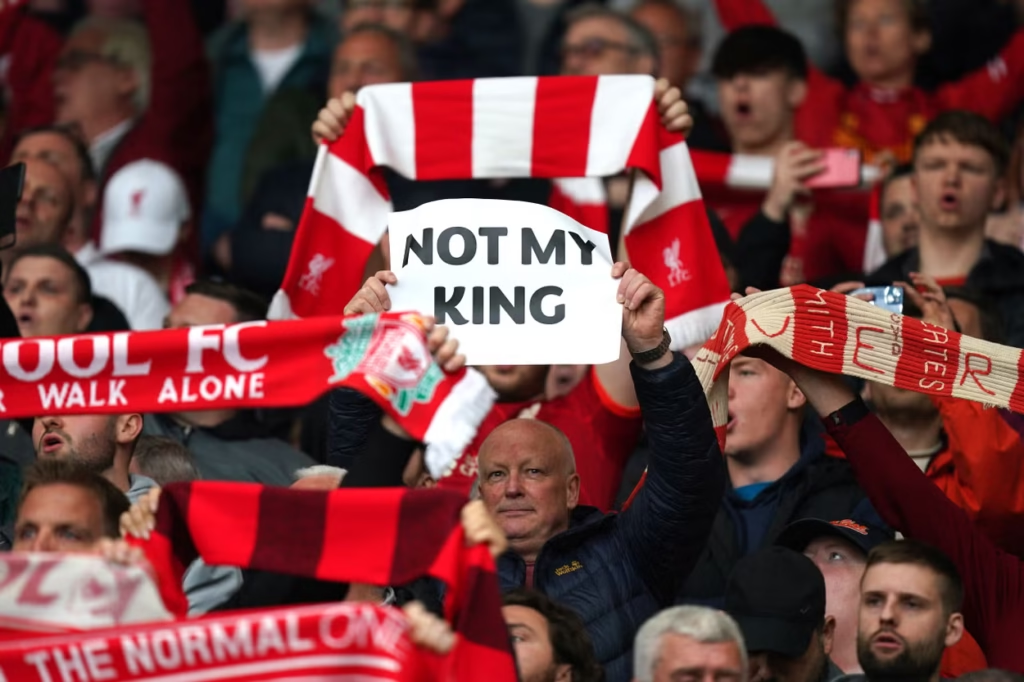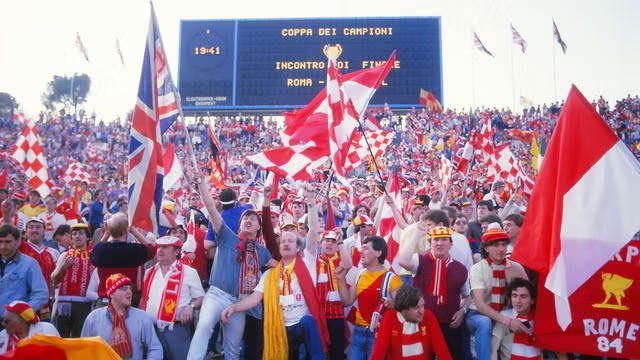On Sunday afternoon, Liverpool took to the pitch for the Community Shield final against Crystal Palace.
As the sun shone, and as the first notes of the national anthem even began to play, murmurs between fans devolved into whistles and shouts.
Boos swelled and rose in volume and confidence with every passing second At last, the boos were drowning out the PA system.
This is not new, though, of course. This is a decades-old familiar tradition brought to domestic finals by Liverpool fans akin to say, a scarf, or a lapel-pin cladded bucket hat proudly displaying LFC.

But there was once a time where this keen ritual would have been an absurd display to a former Liverpool fanbase.
Once deemed a fiercely patriotic city, both Liverpool and Everton fans routinely draped their respective clubs’ names on Union Jacks – the Kop and Gwladys Street transformed into vibrant tapestries of local pride woven through British symbolism.
A longstanding pastime on the Kop was a vocal duel of chants between “Celtic!” and “Rangers!” – an ode to the sectarian tensions that still lingered in the city at the time, with the “Rangers” cohort often dominating the noise.
An amusing quirk of history is that in 1984 – during the Thatcher-era which is often attributed to Liverpool’s modern-day grievances – Liverpool fans excitedly arrived in Rome ahead of the European Cup final fiercely waving those flags.
Evidently, outward expressions of national pride were in no way incompatible alongside red flags; Liverpool fans were once as comfortable singing God Save the Queen as they were to singing You’ll Never Walk Alone.
Perhaps there was a buffer period, whereby the gruelling life under Thatcher’s iron fist and the stereotypes it bred took some time to leave a bitter and rebellious taste in the mouth of the people of Liverpool.
Regardless, it reveals the uncomfortable contradiction – there is an air of historical revisionism to the roots of Liverpool fans booing the national anthem.
A familiar set of origin stories get routinely pulled out of the city’s memory box and dusted off: The city’s Irish heritage, Churchill’s gunboats in 1911, the managed decline memos revealed in 2011.
They’re soaked up and regurgitated because they’re neat and add a punch to the justification surrounding it.
Proponents of such stories almost act as preachers on a soap box lecturing people about tales from the past as if a century-old dock strike or a famine-era migration is what echoes in the memory of the everyday Scouser.
It’s a tidy narrative for outsiders, a way of packaging dissent into something safely historical, rather than confronting the lived experience of being stereotyped and dismissed in the present.
The Liverpool Echo’s Dan Haygarth, in a quite remarkable article, attempted to explain why so many in the city reject national identity.
As explanations go it ticked the right boxes but was conveniently similar to the age-old, self-spun horror story; the stitching together of disparate events and weaving a narrative that seems to share some of the features of an accelerated national story.
It was a perfect reflection of what passes for common sense on this topic.
As the story goes, our 19th-century Irish roots had supposedly transformed us into sure fire “rebels” sceptical of authority; our coastal location transformed us into natural internationalists who looked out rather than in and unashamedly in conflict with our Eurosceptic countrymen; a history of being ‘let down by the establishment’ first by the Thatcher government in the 1980s and then over the Hillsborough disaster had for many “broken the city’s relationship with England beyond repair.”
The latter point assists the most in providing clarity in our self-spun story. Because, for all Liverpool fans’ rushing attempts to remind critics of the ills of the Royal Family – the wealth hoarding, its history of overseeing imperialism, the infamously controversial decision for the late Elizabeth II to defend her defamed son, it does very little to survive scrutiny.
Because, for many, the booing doesn’t even have anything to do with the royals at all.
Of course, there is likely a stauncher anti-monarchy fervour in Liverpool compared to the rest of the country, of which the boos have an irrefutable connection with, but its central focus to it is overstated.
Rather, the boos are often symbolic of something more visceral.
For many, the boos are in fact a middle finger to each and every time they’re referred to as a “bin dipper”; every time they’re dehumanised to “vermin” – which has become all but synonymous with their regional identity.
The boos were a middle finger to every time online outlets have to turn off comments on tributes to Hillsborough; to being forced to swallow and accept a life riddled with injustice and stereotyping.
Thus, rather than a hangover from ancestral vendettas, it’s a middle finger to all of that – a two-finger salute to a life in which being bearing a Scouse accent is indistinguishable with contempt.
Ultimately, the anthem boos aren’t the echo of some inherited vendetta or the neat endpoint of a city’s long political journey.
They speak to something lived – rather than forged tales of mythic connections to lands beyond the horizon, the boos heard at Wembley on Sunday are probably more akin to an othering from a perceived surrounding horde of distinctly unsympathetic neighbours.
Perhaps the tradition will dwindle, but with a youth carrying the torch of the fiercely unsympathetic Scouse rebellious spirit and social media acting as an accomplice to their national alienation, it is safe to say this ritualistic act of defiance is here to stay.

